HYUNDAI IX20 2011 Owners Manual
Manufacturer: HYUNDAI, Model Year: 2011, Model line: IX20, Model: HYUNDAI IX20 2011Pages: 420, PDF Size: 20.53 MB
Page 401 of 420
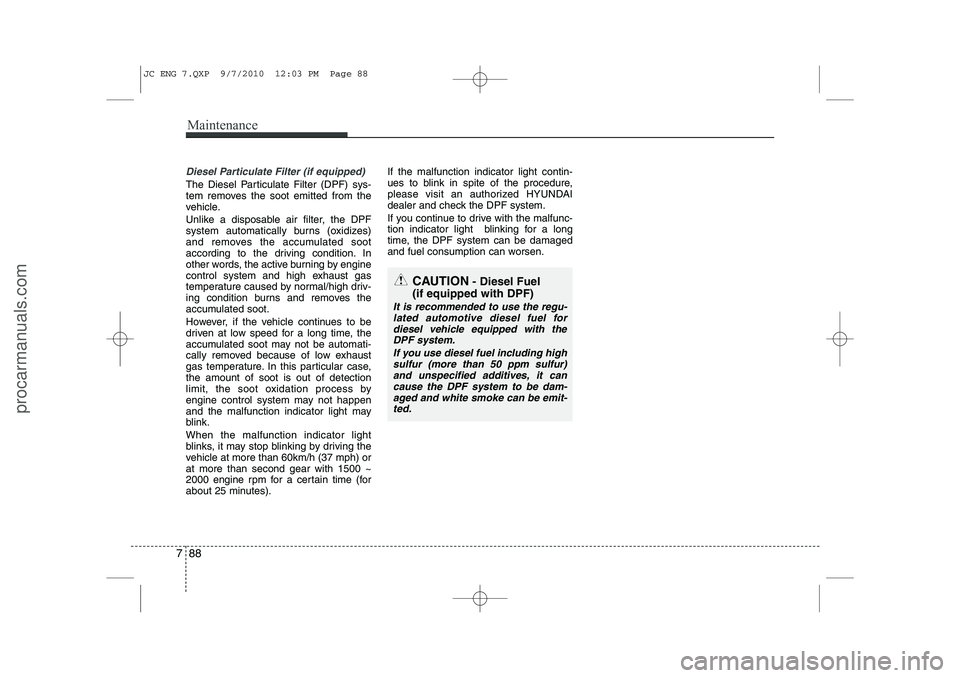
Maintenance
88
7
Diesel Particulate Filter (if equipped)
The Diesel Particulate Filter (DPF) sys-
tem removes the soot emitted from the
vehicle.
Unlike a disposable air filter, the DPF
system automatically burns (oxidizes)
and removes the accumulated soot
according to the driving condition. In
other words, the active burning by engine
control system and high exhaust gas
temperature caused by normal/high driv-
ing condition burns and removes the
accumulated soot.
However, if the vehicle continues to be
driven at low speed for a long time, the
accumulated soot may not be automati-
cally removed because of low exhaust
gas temperature. In this particular case,the amount of soot is out of detection
limit, the soot oxidation process by
engine control system may not happen
and the malfunction indicator light may
blink. When the malfunction indicator light
blinks, it may stop blinking by driving the
vehicle at more than 60km/h (37 mph) orat more than second gear with 1500 ~
2000 engine rpm for a certain time (for
about 25 minutes). If the malfunction indicator light contin-
ues to blink in spite of the procedure,
please visit an authorized HYUNDAI
dealer and check the DPF system.
If you continue to drive with the malfunc-
tion indicator light blinking for a long
time, the DPF system can be damaged
and fuel consumption can worsen.
CAUTION
- Diesel Fuel
(if equipped with DPF)
It is recommended to use the regu- lated automotive diesel fuel fordiesel vehicle equipped with the
DPF system.
If you use diesel fuel including highsulfur (more than 50 ppm sulfur) and unspecified additives, it cancause the DPF system to be dam-
aged and white smoke can be emit-ted.
JC ENG 7.QXP 9/7/2010 12:03 PM Page 88
procarmanuals.com
Page 402 of 420
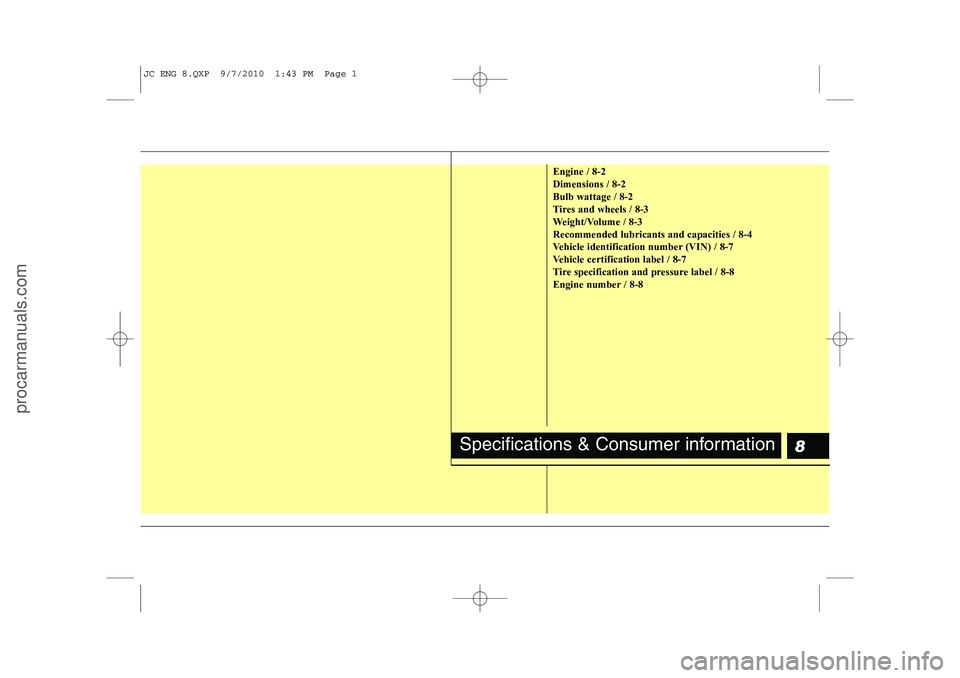
8
Engine / 8-2 Dimensions / 8-2Bulb wattage / 8-2
Tires and wheels / 8-3
Weight/Volume / 8-3Recommended lubricants and capacities / 8-4
Vehicle identification number (VIN) / 8-7
Vehicle certification label / 8-7
Tire specification and pressure label / 8-8
Engine number / 8-8
Specifications & Consumer information
JC ENG 8.QXP 9/7/2010 1:43 PM Page 1
procarmanuals.com
Page 403 of 420
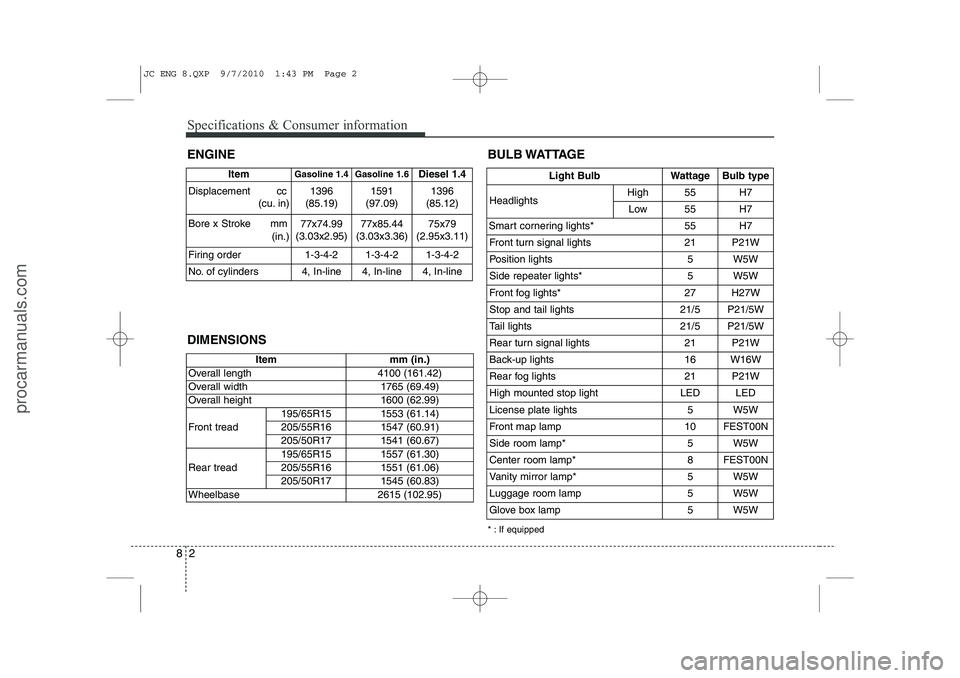
Specifications & Consumer information
2
8
ENGINE DIMENSIONS
Item mm (in.)
Overall length 4100 (161.42)
Overall width 1765 (69.49)
Overall height 1600 (62.99)
Front tread 195/65R15 1553 (61.14)
205/55R16 1547 (60.91)
205/50R17 1541 (60.67)
Rear tread 195/65R15 1557 (61.30)
205/55R16 1551 (61.06)
205/50R17 1545 (60.83)
Wheelbase 2615 (102.95)
Item Gasoline 1.4 Gasoline 1.6
Diesel 1.4
Displacement cc (cu. in) 1396
(85.19) 1591
(97.09) 1396
(85.12)
Bore x Stroke mm (in.)77x74.99
(3.03x2.95) 77x85.44
(3.03x3.36) 75x79
(2.95x3.11)
Firing order 1-3-4-2 1-3-4-2 1-3-4-2
No. of cylinders 4, In-line 4, In-line 4, In-lineLight BulbWattageBulb type
HeadlightsHigh55H7
Low55H7
Smart cornering lights*55H7
Front turn signal lights21P21W
Position lights5W5W
Side repeater lights*5W5W
Front fog lights*27H27W
Stop and tail lights21/5P21/5W
Tail lights21/5P21/5W
Rear turn signal lights 21P21W
Back-up lights16W16W
Rear fog lights21P21W
High mounted stop lightLEDLED
License plate lights5W5W
Front map lamp10FEST00N
Side room lamp*5W5W
Center room lamp*8FEST00N
Vanity mirror lamp*5W5W
Luggage room lamp5W5W
Glove box lamp5W5W
BULB WATTAGE
* : If equipped
JC ENG 8.QXP 9/7/2010 1:43 PM Page 2
procarmanuals.com
Page 404 of 420
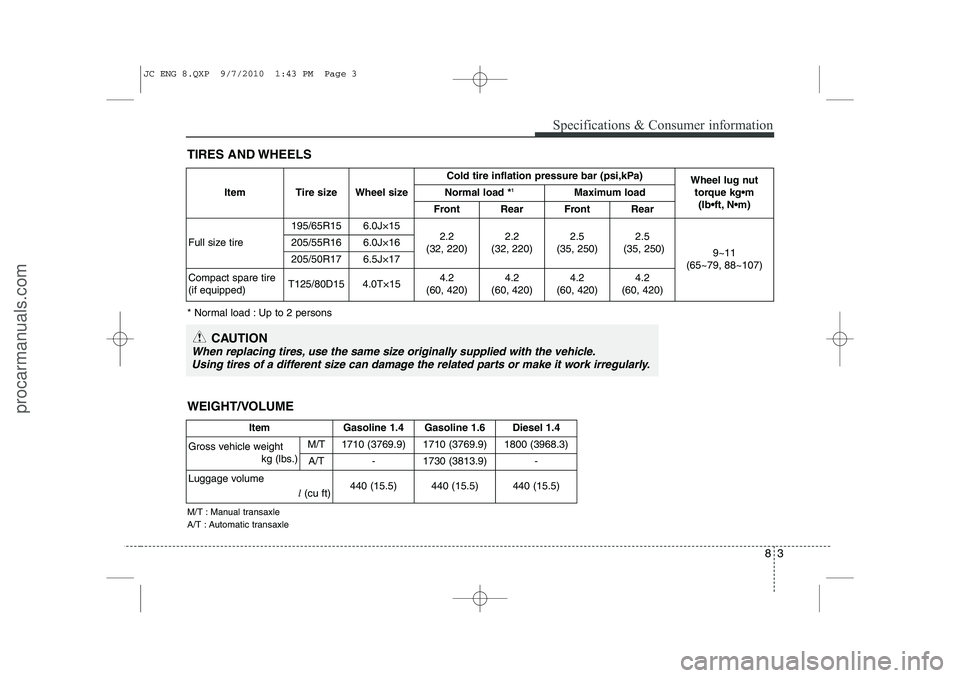
83
Specifications & Consumer information
TIRES AND WHEELS
* Normal load : Up to 2 persons
CAUTION
When replacing tires, use the same size originally supplied with the vehicle.Using tires of a different size can damage the related parts or make it work irregularly.
Item Tire size Wheel size Cold tire inflation pressure bar (psi,kPa)
Wheel lug nut
torque kg•m (lbft, Nm)
Normal load *
1
Maximum load
Front Rear Front Rear
Full size tire 195/65R15 6.0J×15
2.2
(32, 220) 2.2
(32, 220) 2.5
(35, 250) 2.5
(35, 250) 9~11
(65~79, 88~107)
205/55R16 6.0J×16 205/50R17 6.5J×17
Compact spare tire (if equipped) T125/80D15 4.0T×15 4.2
(60, 420) 4.2
(60, 420) 4.2
(60, 420) 4.2
(60, 420)
WEIGHT/VOLUME
Item Gasoline 1.4 Gasoline 1.6 Diesel 1.4
Gross vehicle weight kg (lbs.)M/T 1710 (3769.9) 1710 (3769.9) 1800 (3968.3)
A/T-1730 (3813.9)-
Luggage volume l(cu ft) 440 (15.5) 440 (15.5) 440 (15.5)
M/T : Manual transaxle
A/T : Automatic transaxle
JC ENG 8.QXP 9/7/2010 1:43 PM Page 3
procarmanuals.com
Page 405 of 420
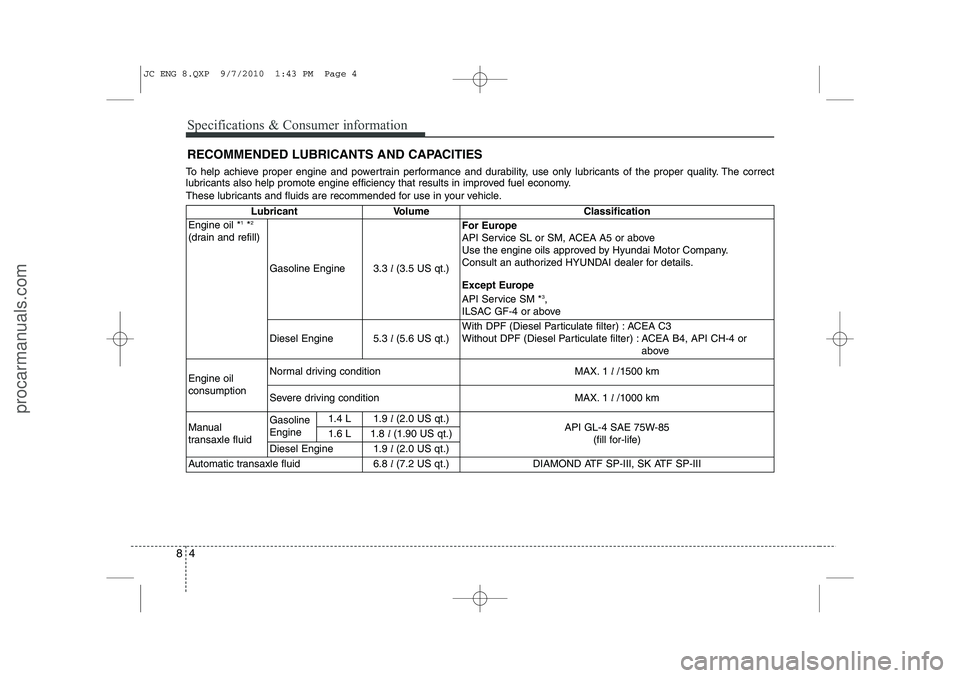
Specifications & Consumer information
4
8
RECOMMENDED LUBRICANTS AND CAPACITIES
To help achieve proper engine and powertrain performance and durability, use only lubricants of the proper quality. The correct
lubricants also help promote engine efficiency that results in improved fuel economy.
These lubricants and fluids are recommended for use in your vehicle.
Lubricant Volume Classification
Engine oil * 1
*2
(drain and refill)
Gasoline Engine 3.3
l (3.5 US qt.) For Europe
API Service SL or SM, ACEA A5 or above
Use the engine oils approved by Hyundai Motor Company.
Consult an authorized HYUNDAI dealer for details.
Except Europe
API Service SM *
3
,
ILSAC GF-4 or above
Diesel Engine 5.3
l (5.6 US qt.) With DPF (Diesel Particulate filter) : ACEA C3
Without DPF (Diesel Particulate filter) : ACEA B4, API CH-4 or
above
Engine oil consumptionNormal driving conditionMAX. 1l /1500 km
Severe driving conditionMAX. 1 l /1000 km
Manual
transaxle fluid GasolineEngine
1.4 L
1.9
l (2.0 US qt.)
API GL-4 SAE 75W-85
(fill for-life)
1.6 L1.8l (1.90 US qt.)
Diesel Engine 1.9
l (2.0 US qt.)
Automatic transaxle fluid 6.8
l (7.2 US qt.)
DIAMOND ATF SP-III, SK ATF SP-III
JC ENG 8.QXP 9/7/2010 1:43 PM Page 4
procarmanuals.com
Page 406 of 420
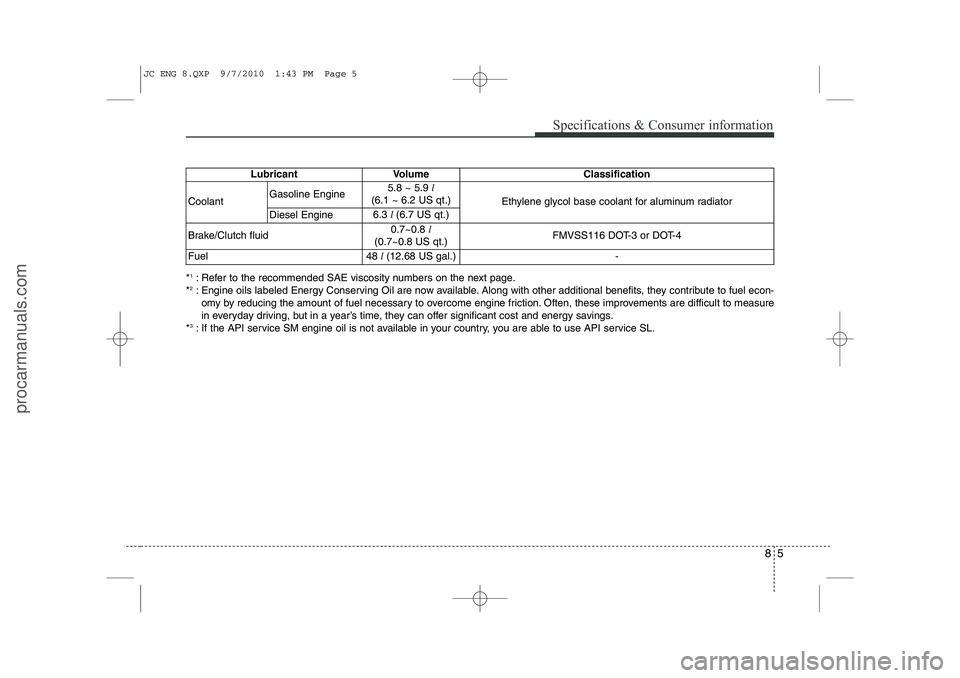
85
Specifications & Consumer information
*1
: Refer to the recommended SAE viscosity numbers on the next page.
* 2
: Engine oils labeled Energy Conserving Oil are now available. Along with other additional benefits, they contribute to fuel econ -
omy by reducing the amount of fuel necessary to overcome engine friction. Often, these improvements are difficult to measure
in everyday driving, but in a year’s time, they can offer significant cost and energy savings.
* 3
: If the API service SM engine oil is not available in your country, you are able to use API service SL. Lubricant Volume Classification
CoolantGasoline Engine5.8 ~ 5.9
l
(6.1 ~ 6.2 US qt.)
Ethylene glycol base coolant for aluminum radiator
Diesel Engine6.3 l (6.7 US qt.)
Brake/Clutch fluid0.7~0.8 l
(0.7~0.8 US qt.)FMVSS116 DOT-3 or DOT-4
Fuel48 l (12.68 US gal.)-
JC ENG 8.QXP 9/7/2010 1:43 PM Page 5
procarmanuals.com
Page 407 of 420
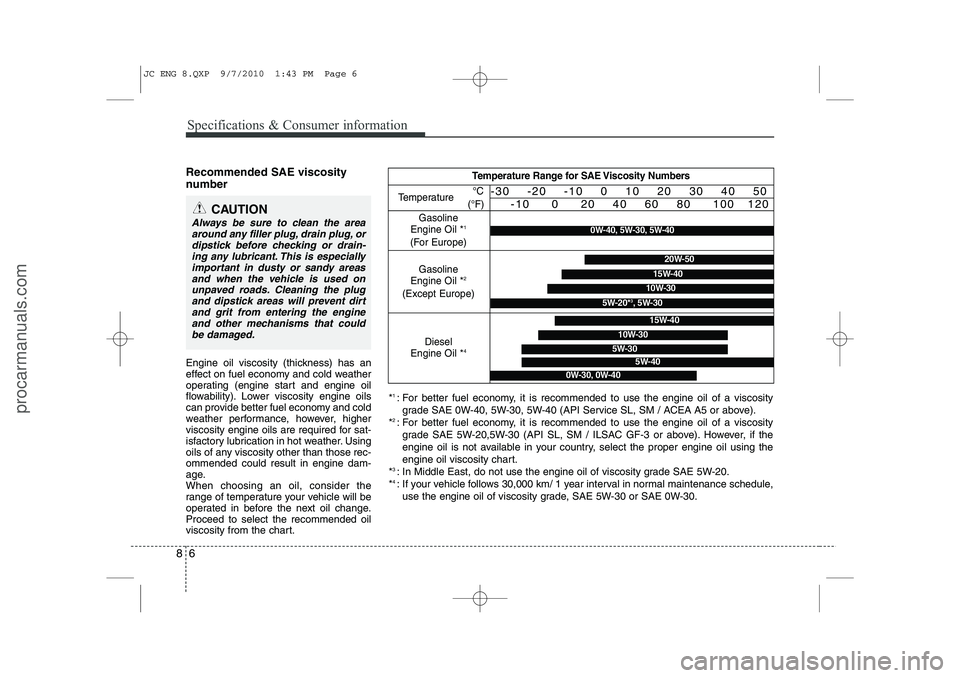
Specifications & Consumer information
6
8
Recommended SAE viscosity
number
Engine oil viscosity (thickness) has an
effect on fuel economy and cold weather
operating (engine start and engine oil
flowability). Lower viscosity engine oils
can provide better fuel economy and cold
weather performance, however, higher
viscosity engine oils are required for sat-
isfactory lubrication in hot weather. Using
oils of any viscosity other than those rec-ommended could result in engine dam-
age.When choosing an oil, consider the
range of temperature your vehicle will be
operated in before the next oil change.Proceed to select the recommended oil
viscosity from the chart.
CAUTION
Always be sure to clean the area
around any filler plug, drain plug, ordipstick before checking or drain-ing any lubricant. This is especially
important in dusty or sandy areas and when the vehicle is used onunpaved roads. Cleaning the plugand dipstick areas will prevent dirt
and grit from entering the engine and other mechanisms that couldbe damaged.
Temperature Range for SAE Viscosity Numbers
Temperature
Gasoline
Engine Oil * 1
(For Europe) °C
(°F)-30 -20 -10 0 10 20 30 40 50 -10 0 20 40 60 80 100 120
Diesel
Engine Oil * 45W-30
15W-40
10W-30
0W-40, 5W-30, 5W-40
Gasoline
Engine Oil * 2
(Except Europe)20W-50
10W-30
15W-40
5W-20* 3
, 5W-30
* 1
: For better fuel economy, it is recommended to use the engine oil of a viscosity
grade SAE 0W-40, 5W-30, 5W-40 (API Service SL, SM / ACEA A5 or above).
* 2
: For better fuel economy, it is recommended to use the engine oil of a viscosity
grade SAE 5W-20,5W-30 (API SL, SM / ILSAC GF-3 or above). However, if the
engine oil is not available in your country, select the proper engine oil using the
engine oil viscosity chart.
* 3
: In Middle East, do not use the engine oil of viscosity grade SAE 5W-20.
* 4
: If your vehicle follows 30,000 km/ 1 year interval in normal maintenance schedule,
use the engine oil of viscosity grade, SAE 5W-30 or SAE 0W-30.
5W-40
0W-30, 0W-40
JC ENG 8.QXP 9/7/2010 1:43 PM Page 6
procarmanuals.com
Page 408 of 420
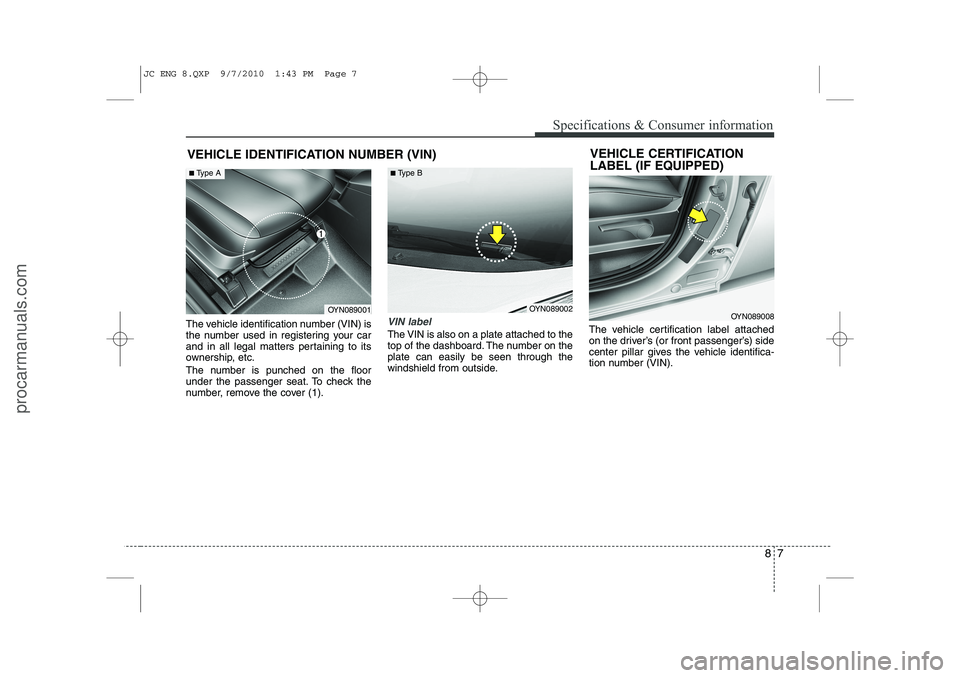
87
Specifications & Consumer information
VEHICLE IDENTIFICATION NUMBER (VIN)
The vehicle identification number (VIN) is
the number used in registering your car
and in all legal matters pertaining to its
ownership, etc.
The number is punched on the floor
under the passenger seat. To check the
number, remove the cover (1).
VIN label
The VIN is also on a plate attached to the
top of the dashboard. The number on theplate can easily be seen through the
windshield from outside. The vehicle certification label attached
on the driver’s (or front passenger’s) side
center pillar gives the vehicle identifica-
tion number (VIN).VEHICLE CERTIFICATION
LABEL (IF EQUIPPED)
OYN089001
■
Type A
OYN089002
■
Type BOYN089008
JC ENG 8.QXP 9/7/2010 1:43 PM Page 7
procarmanuals.com
Page 409 of 420
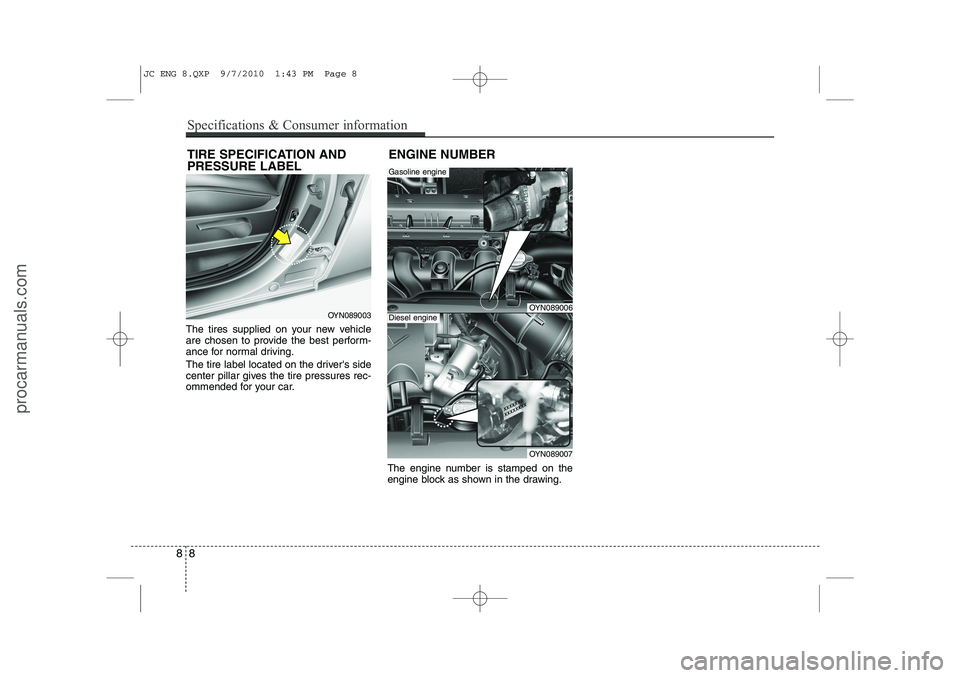
The tires supplied on your new vehicle
are chosen to provide the best perform-
ance for normal driving.
The tire label located on the driver's side
center pillar gives the tire pressures rec-
ommended for your car.The engine number is stamped on the
engine block as shown in the drawing.
OYN089003
TIRE SPECIFICATION AND PRESSURE LABELOYN089006
Gasoline engine
OYN089007
ENGINE NUMBER
Diesel engine
88
Specifications & Consumer information
JC ENG 8.QXP 9/7/2010 1:43 PM Page 8
procarmanuals.com
Page 410 of 420
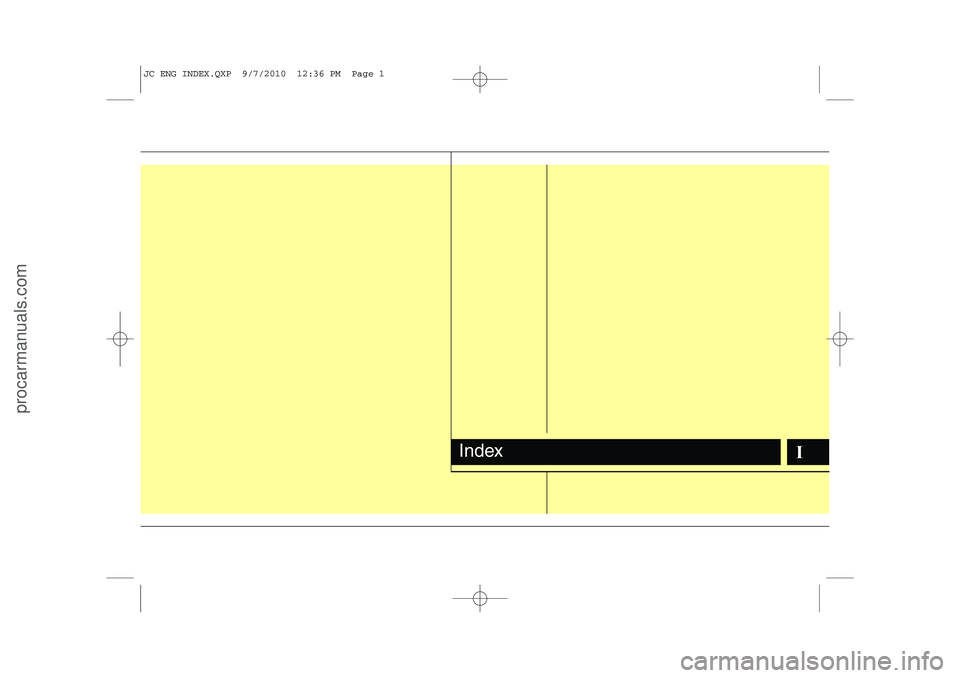
IIndex
JC ENG INDEX.QXP 9/7/2010 12:36 PM Page 1
procarmanuals.com